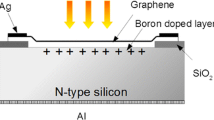Abstract
Two dimensional model of graphene silicon heterojunction solar cell with an inverse doped surface layer is structured using Silvaco TCAD tools by accurate control of ion implantation parameters such as ion beam energy and implantation dose. The I–V characteristics show that the performance of solar cell strongly depends on the inverse layer and doping concentrations. Due to the increase of effective barrier height, the collecting rate of minority carrier generated deep in silicon crystal is enhanced, which is shown by hole current density distribution at Y direction and evidenced by IQE analyses. The obtained maximum efficiency is 0.7332 % at implantation dose of 1e15 cm−2, which is improved significantly compared with normal structure.







Similar content being viewed by others
References
Behura, S.K., Mahala, P., Ray, A., Mukhopadhyay, I.: Theoretical simulation of photovoltaic response of graphene-on-semiconductors. Appl. Phys. A 111(4), 1159–1163 (2013)
Chand, S., Kaushal, P., Osvald, J.: Numerical simulation study of current–voltage characteristics of a Schottky diode with inverse doped surface layer. Mater. Sci. Semicond. Process. 16(2), 454–460 (2013)
Kordoš, P., Marso, M., Meyer, R., Lüth, H.: Schottky barrier height enhancement on n-In0. 53Ga0. 47As. J. Appl. Phys. 72(6), 2347–2355 (1992)
Kuang, Y., Liu, Y., Ma, Y., Xu, J., Yang, X., Hong, X.: Modeling and design of graphene GaAs junction solar cell. Adv. Condens. Matter Phys. 2015, 326384 (2015)
Kuang, Y., Liu, Y., Ma, Y., Hong, X., Yang, X.: Theoretical study on graphene silicon heterojunction solar cell. J. Nanoelectron. Optoelectron. 10(5), 611–615 (2015)
Li, X., Zhu, H., Wang, K., Cao, A., Wei, J., Wu, D.: Graphene-on-silicon Schottky junction solar cells. Adv. Mater. 22(25), 2743–2748 (2010)
Li, Y.F., Yang, W., Tu, Z.Q., Liu, Z.C., Yang, F., Zhang, L.Q.: Schottky junction solar cells based on graphene with different numbers of layers. Appl. Phys. Lett. 104(4), 043903 (2014)
Liu, S., Yuan, X., Wang, P., Chen, Z.G., Tang, L., Zhang, E., Chen, C.: Controllable growth of vertical heterostructure GaTe × Se1 – x/Si by molecular beam epitaxy. ACS Nano 9(8), 8592–8598 (2015a)
Liu, Z., Xu, J., Chen, D., Shen, G.: Flexible electronics based on inorganic nanowires. Chem. Soc. Rev. 44(1), 161–192 (2015b)
Lucky, Wu, G.J., et al.: The Semiconductor Device Physics, pp. 232–256. Xi’an Jiaotong University Press, Xi’an (2008)
Miao, J., Hu, W., Guo, N., Lu, Z., Liu, X., Liao, L., Wang, L.: High responsivity Graphene/InAs nanowire heterojunction near infrared photodetectors with distinct photocurrent on/off ratios. Small 11(8), 936–942 (2015)
Ponpon, J.P., Siffert, P.: Open-circuit voltage of MIS silicon solar cells. J. Appl. Phys. 47(7), 3248–3251 (1976)
Shannon, J.M.: Reducing the effective height of a Schottky barrier using low-energy ion implantation. Appl. Phys. Lett. 24(8), 369–371 (1974)
Shannon, J.M.: Control of Schottky barrier height using highly doped surface layers. Solid-State Electron. 19(6), 537–543 (1976)
Wang, L., Jie, J., Shao, Z., Zhang, Q., Zhang, X., Wang, Y., Lee, S.T.: MoS2/Si heterojunction with vertically standing layered structure for ultrafast, high-detectivity, self-driven visible-near infrared photodetectors. Adv. Funct. Mater. 25(19), 2910–2919 (2015)
Wu, C.Y.: Barrier height reduction of the Schottky barrier diode using a thin highly doped surface layer. J. Appl. Phys. 51(9), 4919–4922 (1980)
Wu, Y., Zhang, X., Jie, J., Xie, C., Zhang, X., Sun, B.: Graphene transparent conductive electrodes for highly efficient silicon nanostructures-based hybrid heterojunction solar cells. J. Phys. Chem. C 117(23), 11968–11976 (2013)
Xie, C., Jie, J., Nie, B., Yan, T., Li, Q., Lv, P.: Schottky solar cells based on graphene nanoribbon/multiple silicon nanowires junctions. Appl. Phys. Lett. 100(19), 193103 (2012)
Yuan, X., Tang, L., Wang, P., Chen, Z., Zou, Y., Su, X., Chen, F.: Wafer-scale arrayed pn junctions based on few-layer epitaxial GaTe. Nano Res. 8(10), 3332–3341 (2015)
Zheng, Q.B., Gudarzi, M.M., Wang, S.J., Geng, Y., Li, Z., Kim, J.K.: Improved electrical and optical characteristics of transparent graphene thin films produced by acid and doping treatments. Carbon 49(9), 2905–2916 (2011)
Acknowledgments
The project was supported by research fund of Jiangsu Province Cultivation base for State Key Laboratory of Photovoltaic Science and Technology (No. SKLPSTKF201505), National Natural Science Foundation of China (Nos. 61306122, 61404012, 11347021).Thanks are also given to The Shanghai Institute of Technical Physics (SITP) for software support.
Author information
Authors and Affiliations
Corresponding author
Rights and permissions
About this article
Cite this article
Kuang, Y., Zhang, D., Ma, Y. et al. Effect of near surface inverse doping on graphene silicon heterojunction solar cell. Opt Quant Electron 48, 199 (2016). https://doi.org/10.1007/s11082-016-0471-8
Received:
Accepted:
Published:
DOI: https://doi.org/10.1007/s11082-016-0471-8



